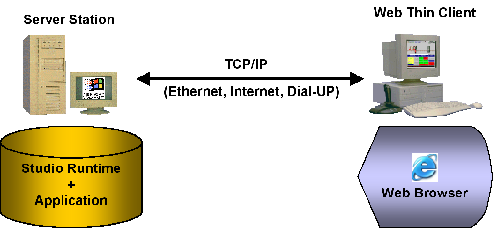IWS is built on a Client/Server architecture, and you can support both Thin Clients and Thick Client. The choice of the type of Client architecture depends upon your system requirements.
Thick Client
A Thick (Fat) Client is a computer that performs most, if not all, of the processing activity. The Thick Client has sufficient processing power, memory, memory, graphics, etc. to run the project. The Thick Client can exchange data with the Server as required (e.g., archival of data, program synchronization). A Server can also be a Thick Client to another Server.
Thin Client
- Microsoft Internet Explorer. This type of browser is best for desktop or remote access environments.
- InduSoft's Secure Viewer, a dedicated viewer for IWS projects. Secure Viewer does not let the user browse to other websites, and will only connect to a specified IWS Server. Secure Viewer is intended for plant floor environments were browsing to other web sites is not required or desired.
In this chapter, we will explore using Thin Clients with IWS. Thick Clients will be covered in a subsequent chapter.
Thin Clients in IWS

IWS is installed on the Server station only. Also, the project (screen files, tags database, configuration worksheets, etc.) is stored on the Server only. You do not need to install the development application or the runtime project on the Thin Client. This solution provides a high level of flexibility because any computer physically linked to the Server station (via a TCP/IP link) can access the graphical screen and online/history data from the Server without installing the development application or the runtime project on the Thin Client stations.
All background tasks (Math, Scheduler etc) and communication tasks (e.g., Driver, OPC, DDE TCP/IP) are executed only on the Server station. The Thin Client is able to load the graphical interface configured on the Server (screens with objects and animations) and display the online values from the tags configured in the server, as well as history data (Alarm, Events and Trend history data).
Any computer or device (e.g., a PDA powered by Windows Mobile 5.0) running Microsoft Internet Explorer 6.0 (or later) or our Secure Viewer program can be a Thin Client for your project. Moreover, IWS provides a sophisticated Security System to prohibit unauthorized access to the project.
From the Thin Client, you are able to visualize data from the Server and capable of changing set points, acknowledging alarms and/or sending commands to the Server. When configuring the project, you can optionally enable or disable all commands from the Thin Client to the Server. Even if the Server has disabled all command from the Thin Client, the Thin Client can still read data from the Server but cannot send any data to the Server.
Thin Client Competitive Advantages
- The IWS Server supports a large number of concurrent Thin Clients (up to 128 IE-based and 128 Secure Viewer-based). Each Thin Client can view the same or different screens as another Thin Client.
- The IWS Server knows which display each Thin Client viewing and automatically "pushes" any updated Tag values to the Thin Client, keeping the Thin Client display current and eliminating the need for screen refreshes
- The IWS Server can support runtime language switching for each Thin Client. This means that one Thin Client can be viewing a screen in English while another Thin Client can display the same screen in Spanish.
Many competitive products offer either a static display on a Thin Client (i.e., it must be manually "refreshed" to get the latest data), a Terminal Server solution (requires the Server to build multiple instances of the project to support each Thin Client), or offer a Thin Client solution similar to IWS but with expensive "add-on" software products.
- Optional Secure Viewer that does not allow navigation outside the IWS project. Secure Viewer is not based on Microsoft's Internet Explorer.
- Ability to run VBScript and the Built-in Scripting Language on the Thin Client
- Can build Thin Client projects using Windows Embedded devices as the Server.
- Ability to support redundant Web Servers and Data Servers, with automatic switchover.
Thin Client Licensing
The maximum number of Thin Client stations connected simultaneously to the Server depends on the settings of the license installed on the Server. The user does not have to install any license on the Thin Client. For more information, see License Settings.